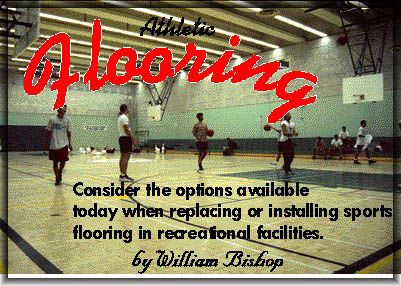

This article will concentrate on flooring for athletic school, gymnasiums and the replacement of existing gymnasium floors in schools, not furnished with a hardwood floor.
Hardwood floors have been the primary installation in secondary schools, constructed by the Board. This floor is the most expensive type of floor available and is generally preferred by physical education instructors. Hardwood floors are designed with an intricate sub-flooring, to provide for shock absorption, while the athlete is running or jumping. The floor must be kept clean and free of dust at all times, to provide proper traction for the athlete. Use of the gymnasium must also be carefully monitored and only participants with the proper footwear should be allowed on the floor.
After approximately two and a half years of use, hardwood floors required sanding down, repainting of gamelines, and the whole surface refinished, at a cost of approximately $12,000.00. In contrast, an alternate sports floor could last up to 20 years, requiring regular cleaning and except for minor line painting, no major maintenance overhauls.
Many athletic facilities currently have either a barwood floor or a standard vinyl tile floor. The barwood floor is a concrete composite floor which is a very hard surface and is no longer available. Vinyl tile floors have a life expectancy of approximately 10 to 15 years, but begins to look very shabby after the first few years, as individual tiles are damaged and replaced by ones which never seem to match the original tiles. Vinyl tile floors are also very hard and have very poor absorption qualities, which can result in sports injuries to the athletes. Large water spills or high humidity, can cause pooling of water on the floor, and results in lifting tiles and the need to replace the floor prematurely. Unlike other sports surfaces, which require only washing and damp mopping, a vinyl tile floor must be stripped, sealed, and waxed at least three times a year and damp mopped regularly. Negative experiences with vinyl tile floors has prompted many building and plant departments to investigate alternate floor coverings for gymnasiums.
This chart indicates that when maintenance costs are applied to the initial cost and divided out by the life expectancy of the floor. Cost comparative chart for a gymnasium of 5,000 sq. ft:

Life expectancy is based on actual knowledge of vinyl tile floors in the system. A 20-year life expectancy was used as the figure for the synthetic floor, while wood floors can be expected to last the life of the school, unless they are not maintained or the floor is flooded.
Approximate initial cost is based on $3.00 per square foot for vinyl tile, $8.00 per square foot for synthetic, and $13.00 per square foot for a wood floor. Initial cost/life expectancy provides a cost per year figure for equal comparison. Maintenance cost/year is the cost of maintaining the floor above and beyond regular scheduled cleaning.
Vinyl tile floors must be stripped, sealed, and waxed three times a year, resulting in approximately 48 man hours at $20.00 per hour = $960.00 per year, plus $250.00 per year for materials such as stripper, sealer, and wax for a total cost of $1,210.00 per year. Maintenance repair costs for tile replacements are not include.
Synthetic surfaces require only regular cleaning, but may require line repainting or touch-up every five years at approximately $1,000.00 per year per five years = $200.00 per year.
Wood floors also only require regular cleaning, but must be sanded down, lines repainted, and the floor refinished approximately every three years at a cost of approximately $8,000.00 per three years = $2,666.00 Per year.
Total cost/year is the initial cost and the maintenance cost divided out on a per year basis.
Financing cost on the incremental capital cost has not been included in this report. Also, the cost associated with providing a safer and superior playing surface for the Physical Education Program is not included.
The cost comparative chart illustrates that a synthetic flooring system can be a cost effective alternative to vinyl tile flooring. The gymnasiums size will also have an impact on costs, as a larger school gymnasiums and will likely attract more after hours use than a smaller gymnasiums. This increased use will increase the cost of maintaining a vinyl tile floor in those facilities.
William Bishop is an associate writer with Cornerstones Magazine. Research for this article supplied by Taraflex Sports Flooring.